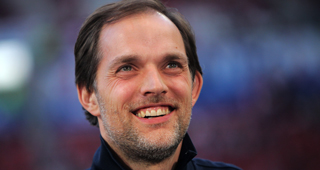The opening 30 minutes of the Champions League final on May 25th, 2013 was peak Jurgen Klopp-era Dortmund. It wasn’t enough that Dortmund battered Bayern Munich, but how: the intense team pressing and speed in attacking transition that defined Klopp was on full display in the biggest club game of the season. The only thing that was missing was a much deserved goal. Bayern slowly found their footing, and eventually won the match with a 89th minute goal against a predictably tired Dortmund side.
In an era of symphonies, Klopp termed his style “rock and roll” soccer with an emphasis on playing fast and loud. But you could go further. It had elements of futuristic science fiction, taking direct play and one touch passing to its fastest extreme (the Footbonaut looks like something out of Blade Runner). The gegenpressing was the three chord punk songs. And of course, Dortmund’s budget made lo-fi team building a necessity.
Individually, the attacking midfield trio of Mario Goetze, Marco Reus and Shinji Kagawa combined speed, dribbling and a quick mind to pass and dribble behind defenders. The Champions League loss was disappointing, but with two league titles and Kagawa the oldest of the trio at 24 years old, the future of rock and roll soccer could only burn brighter.
Of course, the major record companies dressed up as European soccer elites had other ideas. Bayern Munich not only beat Dortmund that day, they also took Dortmund youth product Goetze that summer (which Klopp called a “heart attack”), and Lewandoski the following summer. Shinji Kagawa went to Manchester United. Klopp lost his rhythm section.
Dortmund Loses Its Touch
Just two years later, Klopp was catatonic, out of answers, and at the mercy of his home supporters. Upstart managers with innovative philosophies and formations come and go as much as bands themselves. Diego Simeone’s realism replaced Klopp’s rock and roll the next season. Brendan Rodgers, a genius just three months ago, is rumored to be replaced by Klopp at the end of the season.
The blueprint for clubs without a billionaire backer is to combine youth development with savvy transfer signings. In addition to Goetze and Reus, Nuri Sahin was another product of their youth academy that made up the quick thinking midfield. Robert Lewandowski cost the club just $4.5 million. Shinji Kagawa was discovered in Japan’s second division and signed for $300,000. The backbone of the defense, Mats Hummels and Neven Subotic, totaled under $10 million.
The signings, along with Goetze and Reus’ success, displayed the strength of Dortmund’s scouting and development infrastructure. Their recent run also highlighted the importance of the side’s continuity from the youth academy in Klopp’s attacking style. It was a understanding that the new signings, even though they were higher priced, could never replicate (imagine Barcelona attempting to cobble together a passing midfield from the transfer market in two seasons).
In came three players to replace the outgoing attackers like for like – striker Ciro Immobile for Robert Lewandowski, Henrikh Mhkitaryan for Kagawa, and Pierre-Emerick Aubameyang for Goetze. The three cost some $60 million. Expected to take over creative duties, Mhkitaryan was especially disappointing as Klopp experimented with new formations built around unlocking his passing ability. Yet Mhkitaryan still found himself on the bench with Dortmund near the relegation zone for much of this season scoring only 40 league goals, compared to 80 goals in their 2012 title season.
Rock and roll soccer upgraded to a nicer studio at the cost of their initial spark and edge. And in the Dortmund paradox of being in the same league as Bayern Munich, Klopp was too successful.
Or, Dortmund’s struggles this season could simply be explained as a lack of goals.
Dortmund’s Innovation Problem
“Bayern Munich want to destroy us” – Borussia Dortmund chief executive Hans-Joachim Watzke
Dortmund went back into the Mainz coaching laboratory that produced Klopp and hired Thomas Tuchel as his successor. Tuchel arrives with Klopp’s innovative approach to crowding space in the midfield, an emphasis on youth players, and perhaps most importantly, high hipster ratings.
The shape of Dortmund changes immediately, with Tuchel’s 5-2-2-1 pentagon midfield formation. The midfield four’s narrow is built to crowd out opposition attacks through the middle. The high pressing remains, but like Klopp before him, is taken to a stylistic extreme. Tuchel’s press is recontextualizing Klopp’s style, so it’s easy to imagine the quickness of Kagawa, Reus, and Immobile adjusting and given new life (discussing possession percentages of Tuchel and Klopp is as close to dancing about architecture as the sport gets). While the defense will have to be rebuilt, the pentagon allows Dortmund to remain in the forefront of space manipulation, and even more importantly, one step ahead of Bayern.
With or without Klopp, Dortmund’s two biggest questions remain. The obvious is how to compete in Champions League every season on a middle class budget (here, they have their blueprint of developing youth, scouting cheap talent, and a manager ahead of their time). The second is how to adjust once Bayern Munich inevitably signs their players and implements their ideas. It’s this second stage where Tuchel will be tested, and where Klopp never adjusted. And Tuchel does come with a history of beating their biggest rival.
As for the immediate future, Mkhitaryan, Mats Hummels and Ilkay Gundogen are rumored to leave this summer. It might be best for Tuchel and Dortmund to start over with new, young, energetic legs at the foundation of his pentagon to build upon the reference point and identity that Klopp gave the club. Besides, the success of both rock and roll, and soccer managers according to Pep Guardiola, was never meant to be measured in longevity.



